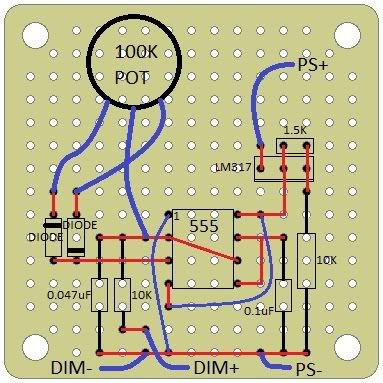Sweet! I get to ask myself a question!
Q: So now that I have one of those new Meanwell ELN-60-48-P drivers, how do I use them properly?!?!
A: welll, there are a few things you need to know about this driver to implement it
1) LED string limits: These drivers have a minimum and maximum # of LEDs you can run on them. For those running the Crees from the group buy, you want to run between 6 and 13 LEDs. NO MORE than 13 and NO LESS than 6. Doing so is unstable and will result in fried LEDs and/or driver.
2) The drivers have an adjustable maximum outout control. Unless someone wants to push the limits, eveyone should open up their driver (4 small screws) and locate an adjustable pot labeled SVR2 (NOT SVR1). Turn this pot CounterClockwise till it stops (don't over tighted). This should set the MAXIMUM driver output to -25% of the original max. --> 1.3A * 0.75 = 0.98A. If you have a multimeter, double check this. 0.98A is an estimate.
3) Most people may want to just turn the LEDs on and off and to do this, you just need to supply 10V to the dim wires. if you supply no voltage, the drivers will not turn on your LEDs. You can decide if you want to turn on and off your LEDs by putting the driver or dim power on a timer.
IMPORTANT: You can probably supply less than 10V in the range of 8-10V. I haven't tested this, but it is reported at 5V is too low. You can't supply more than 10.6V or it will damage the dimming circuit.
IMPORTANT: Typical wallwarts are unregulated. The indicated output on them are not what they put out. A typical 12VDC wall wart can put out 10-14V or so depending on their load. If you are using a wallwart, I would try something like an 8VDC wallwart unless you have a regulated one.
If you want to dim the drivers...this is where it gets fun. It is really a lot easier than it sounds. These drivers use a Pulse Width Modulated (PWM) digital signal to dim. The input requires a 10V signal with modulation frequency ranging from 100hz to 3khz. A duity cycle of 11% will result in 15% current output (minimum controllable level) and 100% will result in 95% current output (maximum controllable level) If you are using two drivers, you can separate your white and blue LEDs on different drivers and use PWM to control their relative value and thus change the "color" of your tank ranging from >20,000K to around 6,000K
How to do PWM? well, someone on another forum has already done a fair bit of work for us.
Here is his design which I trust works perfectly. The parts are available at your local radioshack and should be pretty cheap. You need one per independently controlled driver
Black lines are component leads
Red lines are bottom side solder traces
Blue lines are top side wires
Use a 12v or greater (up to 32v) power supply for this. A 12VDC wallwart should work perfectly fine for this. You hook the wallwart up to the +/- PS points
Hope this helps! If you have questions, feel free to ask


